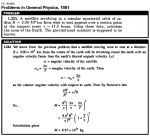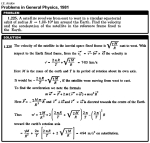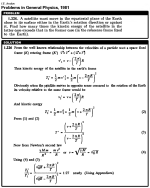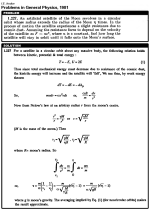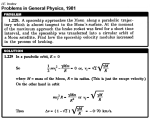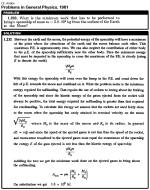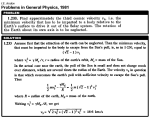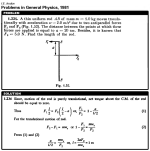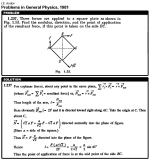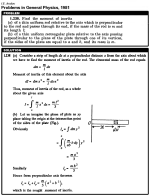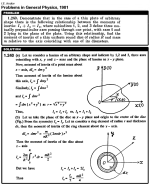| № |
Condition |
free/or 0.5$ |
| 221 | On the pole of the Earth a body is imparted velocity v0 directed vertically up. Knowing the radius of the Earth and the free-fall acceleration on its surface, find the height to which the body will ascend. The air drag is to be neglected. |
|
| 222 | An artificial satellite is launched into a circular orbit around the Earth with velocity v relative to the reference frame moving translationally and fixed to the Earth's rotation axis. Find the distance from the satellite to the Earth's surface. The radius of the Earth and the free-fall acceleration on its surface are supposed to be known. |
|
| 223 | Calculate the radius of the circular orbit of a stationary Earth's satellite, which remains motionless with respect to its surface. What are its velocity and acceleration in the inertial reference frame fixed at a given moment to the centre of the Earth? |
|
| 224 | A satellite revolving in a circular equatorial orbit of radius R = 2.00*10^4 km from west to east appears over a certain point at the equator every τ = 11.6 hours. Using these data, calculate the mass of the Earth. The gravitational constant is supposed to be known. |
|
| 225 | A satellite revolves from east to west in a circular equatorial orbit of radius R = 1.00.104 km around the Earth. Find the velocity and the acceleration of the satellite in the reference frame fixed to the Earth. |
|
| 226 | A satellite must move in the equatorial plane of the Earth close to its surface either in the Earth's rotation direction or against it. Find how many times the kinetic energy of the satellite in the latter case exceeds that in the former case (in the reference frame fixed to the Earth). |
|
| 227 | An artificial satellite of the Moon revolves in a circular orbit whose radius exceeds the radius of the Moon rl times. In the process of motion the satellite experiences a slight resistance due to cosmic dust. Assuming the resistance force to depend on the velocity of the satellite as F = av^2, where a is a constant, find how long the satellite will stay in orbit until it falls onto the Moon's surface. |
|
| 228 | Calculate the orbital and escape velocities for the Moon. Compare the results obtained with the corresponding velocities for the Earth. |
|
| 229 | A spaceship approaches the Moon along a parabolic trajectory which is almost tangent to the Moon's surface. At the moment of the maximum approach the brake rocket was fired for a short time interval, and the spaceship was transferred into a circular orbit of a Moon satellite. Find how the spaceship velocity modulus increased in the process of braking. |
|
| 230 | A spaceship is launched into a circular orbit close to the Earth's surface. What additional velocity has to be imparted to the spaceship to overcome the gravitational pull? |
|
| 231 | At what distance from the centre of the Moon is the point at which the strength of the resultant of the Earth's and Moon's gravitational fields is equal to zero? The Earth's mass is assumed to be n = 81 times that of the Moon, and the distance between the centres of these planets n = 60 times greater than the radius of the Earth R. |
|
| 232 | What is the minimum work that has to be performed to bring a spaceship of mass m = 2.0·10^3 kg from the surface of the Earth to the Moon? |
|
| 233 | Find approximately the third cosmic velocity v3, i.e. the minimum velocity that has to be imparted to a body relative to the Earth's surface to drive it out of the Solar system. The rotation of the Earth about its own axis is to be neglected. |
|
| 234 | A thin uniform rod AB of mass m = 1.0 kg moves translationally with acceleration w = 2.0 m/s2 due to two antiparallel forces F1 and F2 (Fig. 1.52). The distance between the points at which these forces are applied is equal to a = 20 cm. Besides, it is known that F2 = 5.0 N. Find the length of the rod. |
|
| 235 | A force F = Ai + Bj is applied to a point whose radius vector relative to the origin of coordinates 0 is equal to r = ai + bj, where a, b, A, B are constants, and i, j are the unit vectors of the x and y axes. Find the moment N and the arm 1 of the force F relative to the point O. |
|
| 236 | A force F1 = Aj is applied to a point whose radius vector r1 = ai, while a force F2 = Bi is applied to the point whose radius vector r2 = bj. Both radius vectors are determined relative to the origin of coordinates O, i and j are the unit vectors of the x and y axes, a, b, A, B are constants. Find the arm l of the resultant force relative to the point O. |
|
| 237 | Three forces are applied to a square plate as shown in Fig. 1.53. Find the modulus, direction, and the point of application of the resultant force, if this point is taken on the side BC. |
|
| 238 | Find the moment of inertia (a) of a thin uniform rod relative to the axis which is perpendicular to the rod and passes through its end, if the mass of the rod is m and its length l; (b) of a thin uniform rectangular plate relative to the axis passing perpendicular to the plane of the plate through one of its vertices, if the sides of the plate are equal to a and b, and its mass is m. |
|
| 239 | Calculate the moment of inertia (a) of a copper uniform disc relative to the symmetry axis perpendicular to the plane of the disc, if its thickness is equal to b=2.0 mm and its radius to R = 100 mm; (b) of a uniform solid cone relative to its symmetry axis, if the mass of the cone is equal to m and the radius of its base to R. |
|
| 240 | Demonstrate that in the case of a thin plate of arbitrary shape there is the following relationship between the moments of inertia: I1 + I2 = I3, where subindices 1, 2, and 3 define three mutually perpendicular axes passing through one point, with axes 1 and 2 lying in the plane of the plate. Using this relationship, find the moment of inertia of a thin uniform round disc of radius R and mass m relative to the axis coinciding with one of its diameters. |
|



